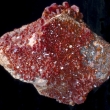Background

- Vanadium is a chemical element with the symbol V and an atomic number of 23. It is a soft, silvery gray, ductile transition metal. Metallic vanadium does not exist in nature but is found in about 65 minerals. Vanadium has a very limited role in biology and is more important in ocean environments than on land. It is used in the production of nonferrous alloys and most resistant carbon steel, as well as in chemical, glass, paint, varnish, ceramic, and photographic industries. Fats, oils, fruits, and vegetables have been shown to contain the least amounts of vanadium, while whole grains, seafood, meats, and dairy products contain greater amounts. Dill seeds and black pepper contain the most.
- Vanadium has been used as a dietary supplement; for treating low blood sugar, high cholesterol, heart disease, tuberculosis, syphilis, anemia, and edema; and for preventing cancer. More high-quality human research is needed to make a conclusion about the safety and effectiveness of vanadium for any condition.
Scientific Evidence
| Uses | Grade* |
| Diabetes
Vanadium may act like insulin in the body and may improve how patients with diabetes use glucose. Well-designed studies are needed before a conclusion can be made. |
B |
| Alcohol-induced hangover
There is limited human research investigating the effects of vanadium on alcohol-induced hangover. More studies are needed in this area. |
C |
| Dialysis (hemodialysis)
There is limited human research investigating the effects of vanadium on hemodialysis. High-quality studies are needed in this area. |
C |
| Hepatocellular carcinoma
Early studies suggest that vanadium may improve symptoms associated with cancer of the liver. Additional studies are needed before a conclusion can be made. |
C |
| High blood pressure
Early studies suggest that vanadium may improve high blood pressure. Additional studies are needed in this area. |
C |
*Key to grades:
A: Strong scientific evidence for this use;
B: Good scientific evidence for this use;
C: Unclear scientific evidence for this use;
D: Fair scientific evidence against this use (it may not work);
F: Strong scientific evidence against this use (it likely does not work).
Tradition
- Anemia, anticoagulant, antioxidant, antiviral, atherosclerosis, cancer, dental procedures (dental implants), edema, heart disease, high cholesterol, HIV, liver protection, low blood sugar, metabolic syndrome, obesity, syphilis, total parenteral nutrition, tuberculosis, vitamin and nutrient deficiency (vanadium deficiency).
Dosing
Adults (18 years and older)
- An average diet may provide 6-20 micrograms of vanadium daily. There is no proven safe or effective dose for vanadium in adults.
Children (under 18 years old)
- There is no proven safe or effective dose for vanadium in children.
References
- Aureliano, M. and Crans, D. C. Decavanadate (V10 O28 6-) and oxovanadates: oxometalates with many biological activities. J Inorg.Biochem 2009;103(4):536-546. View Abstract
- Bevan, A. P., Drake, P. G., Yale, J. F., et al. Peroxovanadium compounds: biological actions and mechanism of insulin-mimesis. Mol.Cell Biochem 12-6-1995;153(1-2):49-58. View Abstract
- Bishayee, A., Waghray, A., Patel, M. A., et al. Vanadium in the detection, prevention and treatment of cancer: the in vivo evidence. Cancer Lett 8-1-2010;294(1):1-12. View Abstract
- Boden G, Chen X, Ruiz J, et al. Effects of vanadyl sulfate on carbohydrate and lipid metabolism in patients with non-insulin dependent diabetes mellitus. Metabolism 1996 45 (9): 1130-5. View Abstract
- Goldfine AB, Patti ME, Zuberi L, et al. Metabolic effects of vanadyl sulfate in humans with non-insulin-dependent diabetes mellitus: in vivo and in vitro studies. Metabolism. 2000 49 (3): 400-10. View Abstract
- Goldwaser, I., Gefel, D., Gershonov, E., et al. Insulin-like effects of vanadium: basic and clinical implications. J Inorg.Biochem 5-30-2000;80(1-2):21-25. View Abstract
- Halberstam M, Cohen, N, Shlimovich P, et al. Oral vanadyl sulfate improves insulin sensitivity in NIDDM but not in obese nondiabetic subjects. .Diabetes 1996 45(5): 659-66. View Abstract
- Henquin, J. C. and Brichard, S. M. [Role of vanadium in the treatment of diabetes mellitus. Experimental data and clinical applications]. Presse Med 6-27-1992;21(24):1100-1101. View Abstract
- Kleinsasser, N., Dirschedl, P., Staudenmaier, R., et al. Genotoxic effects of vanadium pentoxide on human peripheral lymphocytes and mucosal cells of the upper aerodigestive tract. Int J Environ.Health Res 2003;13(4):373-379. View Abstract
- Neve, J. Clinical implications of trace elements in endocrinology. Biol Trace Elem.Res 1992;32:173-185. View Abstract
- Romero, R. A. Aluminum, vanadium, and lead intoxication of uremic patients undergoing hemodialysis in Venezuela. Transplant.Proc 1994;26(1):330-332. View Abstract
- Shioda, N., Morioka, M., and Fukunaga, K. [Vanadium compounds enhance adult neurogenesis after brain ischemia]. Yakugaku Zasshi 2008;128(3):413-417. View Abstract
- Thompson, K. H. and Orvig, C. Vanadium compounds in the treatment of diabetes. Met.Ions.Biol Syst. 2004;41:221-252. View Abstract
- Whanger, P. D. Selenium and the brain: a review. Nutr Neurosci. 2001;4(2):81-97. View Abstract
- Yeh GY, Eisenberg DM, Kaptchuk TJ, et al. Systematic review of herbs and dietary supplements for glycemic control in diabetes . Diabetes Care. 2003 Apr;26(4):1277-94. View Abstract